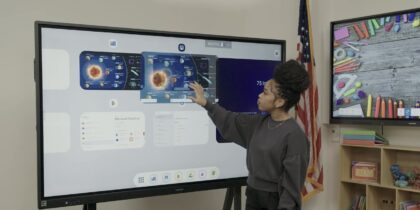Over the years, school systems have invested heavily in placing technology in the classroom. Estimates show that the K-12 edtech market is likely to hit a value of $1.83 billion by 2020, according to research firm Futuresource Consulting. Yet some argue that the near-constant updates make it financially impossible for schools to keep up — and we might be doing our students a disservice by training them to use outdated technologies they’ll never encounter in the real world.
How do we measure technology ROI in education environments? And how can education leaders ensure that our school boards and other elected officials continue to see the value of that investment?
Here are three main ways technology in the classroom provides value:
- Technology tools facilitate authentic environments. When students begin working, they’ll enter businesses that depend on technology. Nearly every industry uses technology tools, and students who are comfortable with technology will be at an advantage in business. This means schools should use the technology they have available in ways that mimic the real world — and in ways that take advantage of students’ comfort using technology tools and teachers’ ability to guide them in using the tools appropriately for the task at hand.
- Technology facilitates collaboration and other soft skills. One of the most attractive features of technology is that it opens up new ways of working and collaborating — and that is what students need to learn about using technology in the workplace. In-person and online collaborations happen using tablets, smartphones, Chromebooks and other technology tools. That’s why the best uses of technology in the classroom aren’t teaching specific coding languages or tools. Instead, they are teaching collaboration, teamwork, communication and lifelong learning.
- Technology allows students to access interactive learning materials. Many schools don’t have the time or budget to incorporate as many hands-on activities and field trips as they used to, but technology offers them access to the typical activities many of us grew up with — and a whole lot more. Students can simulate dissection, access primary historical resources without leaving the classroom, watch scientists in action, connect with scientists and professionals around the globe, take trips to various locations throughout the world and more.
ROI for Schools Can Be Measured in Immediate Savings
Return on investment is a long-used metric for businesses, but many of the benefits to students can’t be measured in a timely fashion or in terms of a monetary value. However, if you look at ways to get the most out of your purchase, rather than just whether you’re getting an ROI on technology in general, you can see some significant financial benefits.
Get Creative With Funding Solutions
Download the white paper for a guide to securing funding for education technology. Download Now
Start by comparing the initial outlay for new machines to those you’re currently using, especially if you’ll need to replace an entire fleet. You can also assess whether your IT team will be able to more efficiently manage the technology because of an easier method of rolling out software updates and managing other back-end features; if devices are less prone to failure because of a more efficient operating system or rugged construction; and whether the updated devices make it easier to access high-quality digital content and open education resources that can lower expenditures on textbooks and other learning materials.
A School-Specific Method May Also Be a Good Option
Instead of focusing on technology ROI, school districts can also use the Value of Investment (VOI) metric to measure whether an educational investment in technology is a good way to use funds. VOI incorporates ROI but also looks at the benefits of a technology deployment in helping students meet standards and benchmarks, improving teachers’ ability to meet individual learning needs, or helping reach other school or district objectives.
The key in assessing whether any change to the learning system is worth the investment is to look at both the potential learning benefits and the impact on the overall budget. With updated systems, schools can not only lower overall management and upkeep costs, but also provide a diverse, connected learning experience for their students on a daily basis.
Learn about more ways you can incorporate digital technology into your classroom by checking out our full line of educational technology solutions.








